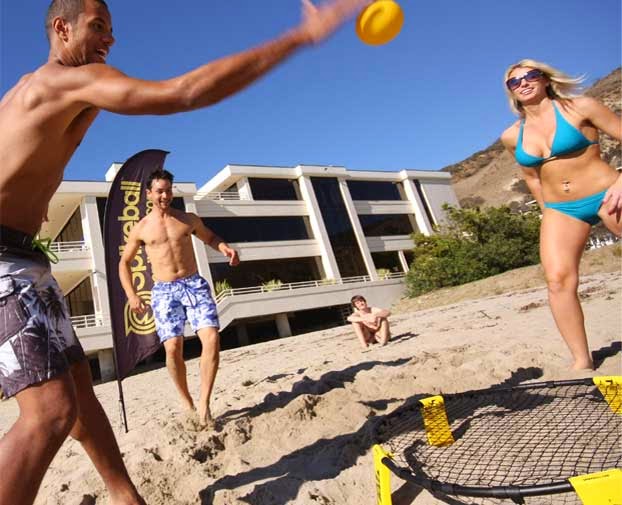Don't let the lack of a fourth player ruin your Spikeball afternoon. Here's how to play Thrikeball.
Thrikeball is Spikeball for three players. The format is 2-on-1. But here's the catch: the teams change every time the ball contacts the net - so a lot. It's easier to track than you might think.
Before we elaborate, the assumption is that you already understand the flow of standard 2-on-2 Spikeball. If not, here are the Official Rules and also a great video tutorial.
In Thrikeball, instead of playing and scoring points as a team, it's every man for himself, and after every rally there is exactly one winner (who gains 2 points) and two losers (who each lose 1 point). The winner is the first player to 10 points, or the player who is in the lead when another player hits -10 points. That's right, negative points.
Gameplay:
- Decide who serves first. We will call this solo player the Spiker. The other two players comprise a team that we will call the Setters.
- The Spiker serves the ball into the net (** see Notes on serving).
- The Setters are allowed exactly two touches to return the ball to the net (not one, not three), one by each member of the team.
- THE SWITCH: The moment the ball hits the net on the return is when the teams change: the Setter who hit the ball second (i.e. into the net) becomes the incumbent Spiker, while the other two become the new Setters (** see Notes on switching).
- Play continues until the Setters fail to legally return the ball to the net in two touches, at which time the current Setters each lose 1 point and the Spiker gains 2 points.
- To begin the next rally, the incumbent Spiker serves to the Setter who has more points. If they are tied, the Spiker serves to the player of his choice.
- Repeat from Step 3 until a player has 10 or more points or until a player has -10 or fewer points. In the latter case, of the remaining two, the player with more points wins (** see Notes on scoring).
Notes on serving:
- As in regular Spikeball, in Thrikeball the server (incumbent Spiker) always gets two chances to serve.
- If both serves are missed (double fault), no points are won or lost but the serve switches to the player with the fewest points. If this player misses both as well, the third player gets to serve. If this player misses, probably just call it a day.
- Remember that the Spiker always serves to the Setter with the most points. This gives the currently losing Setter the chance to score first (assuming the serve wasn't an ace).
- If the Setters are tied, the Spiker serves to the player of his choice. We usually just alternate, but it's ultimately up to you.
Notes on switching:
- The constant switching of teams may seem complicated at first, but after a few rounds it becomes intuitive. We swear.
- The easy way to remember who needs to be doing what is that the person who spiked the ball into the net is the only one not involved in the next volley!
- Again, teams switch at the moment that the ball hits the net on a return. However, the strategic switch effectively occurs after the first Setter sets the ball to his ephemeral teammate, whose inevitable spike he has to start thinking about receiving. Something interesting that you will start to notice right away.
Notes on scoring:
- There will always be three scores (i.e. X to X to X). Each player keeps track of their own score.
- The winning Spiker gets 2 points; the losing Setters each lose 1 point.
- When in doubt on a score, remember that the total of all three scores should always add up to zero. This is a tug-of-war style game in that whenever you win points, you are effectively taking them directly from the other players.
- No points are won or lost on a double fault.
- Below is a flowchart of all possible score combinations and changes. Note that the three scores in each box are positioned in order from highest to lowest, not predetermined by player order.
- As you can see, there is one exception to the game being over once a player has reached either 10 or -10: (5 5 -10) is not a victory because the other two players are still tied, necessitating at least one more rally.
We love Thrikeball not only because it finally facilitates Spikeball with three players but also because of the Nash-like game theory involved. For example, it will become readily apparent to a new player of Thrikeball that if you are on the Setters' team it is best be the second hitter so you can become the new Spiker (and possible points-earner). However, if both Setters hold out on being the first to touch the ball on their volley, they both lose. Thus, the elements of both selfish strategy and cooperative compromise are present in Thrikeball, and it is up to you to figure out the balance.
I thrike it. I thrike it a lot.
Your most earnest trio,
Gavin, James, and Alex
Fort Collins, Colorado



Great read! I am with Spikeball Inc. and would love to share this with our community. If that sounds good to you please email me at Shaun@Spikeball.com and we can figure something out.
ReplyDeleteSpike on!
Hey Gavin,
ReplyDeleteJon from the And Sons Magazine team here. We're in Colorado as well. We've been talking about three man spikeball for a while as our break plans are often foiled by a missing fourth man. We finally did a google search and found this. So much fun! Thanks for putting this out there. And if you're ever in Colorado Springs drop us a line. jon@andsonsmagazine.com